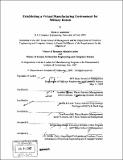| dc.contributor.advisor | Jonathan Byrnes and Steven B. Leeb. | en_US |
| dc.contributor.author | Andersen, Ryan J. (Ryan John) | en_US |
| dc.contributor.other | Leaders for Manufacturing Program. | en_US |
| dc.date.accessioned | 2007-11-16T14:29:58Z | |
| dc.date.available | 2007-11-16T14:29:58Z | |
| dc.date.copyright | 2007 | en_US |
| dc.date.issued | 2007 | en_US |
| dc.identifier.uri | http://hdl.handle.net/1721.1/39591 | |
| dc.description | Thesis (M.B.A.)--Massachusetts Institute of Technology, Sloan School of Management; and, (S.M.)--Massachusetts Institute of Technology, Dept. of Electrical Engineering and Computer Science; in conjunction with the Leaders for Manufacturing Program at MIT, 2007. | en_US |
| dc.description | Includes bibliographical references (p. 174-177). | en_US |
| dc.description.abstract | Recent advances in the robotics industry have given the military an opportunity to capitalize on industry's innovation. Not only has core robotics technology improved but robotics manufacturing technology has also made significant improvements. This has enabled the U.S. military to procure robotic counterparts at an astonishing rate. The military expects to have a significant contingent of robots in the battle field by 2015. Today, "automated or remote-controlled machines are sniffing out mines, defusing explosives and watching for signs of danger".I The Army's Future Combat Systems program to revolutionize the military into a quicker, faster, and more lethal force is predicated on the rapid development of robotics technologies.2 Four out of the twelve vehicle systems being developed under the FCS program are unmanned vehicles requiring advanced robotics technologies. With this rapid pace of development a need for sound manufacturing environments exist to ensure product quality, availability, cost, and continuing innovation. | en_US |
| dc.description.abstract | (cont.) This thesis presents a method for establishing a manufacturing environment for defense robotics that is both viable for industry cooperation and meets the demands of ongoing military procurement. This thesis presents a framework for supplier selection that includes: 1) military contracting requirements and contract manufacturing, 2) public policy review, 3) key skill identification, and 4) manufacturing environment modeling. The research contained in this thesis was conducted in cooperation with iRobot, a military robotics supplier. | en_US |
| dc.description.statementofresponsibility | by Ryan J. Andersen. | en_US |
| dc.format.extent | 177 p. | en_US |
| dc.language.iso | eng | en_US |
| dc.publisher | Massachusetts Institute of Technology | en_US |
| dc.rights | M.I.T. theses are protected by copyright. They may be viewed from this source for any purpose, but reproduction or distribution in any format is prohibited without written permission. See provided URL for inquiries about permission. | en_US |
| dc.rights.uri | http://dspace.mit.edu/handle/1721.1/7582 | |
| dc.subject | Sloan School of Management. | en_US |
| dc.subject | Electrical Engineering and Computer Science. | en_US |
| dc.subject | Leaders for Manufacturing Program. | en_US |
| dc.title | Establishing a virtual manufacturing environment for military robots | en_US |
| dc.type | Thesis | en_US |
| dc.description.degree | S.M. | en_US |
| dc.description.degree | M.B.A. | en_US |
| dc.contributor.department | Leaders for Manufacturing Program at MIT | en_US |
| dc.contributor.department | Massachusetts Institute of Technology. Department of Electrical Engineering and Computer Science | |
| dc.contributor.department | Sloan School of Management | |
| dc.identifier.oclc | 175897571 | en_US |
